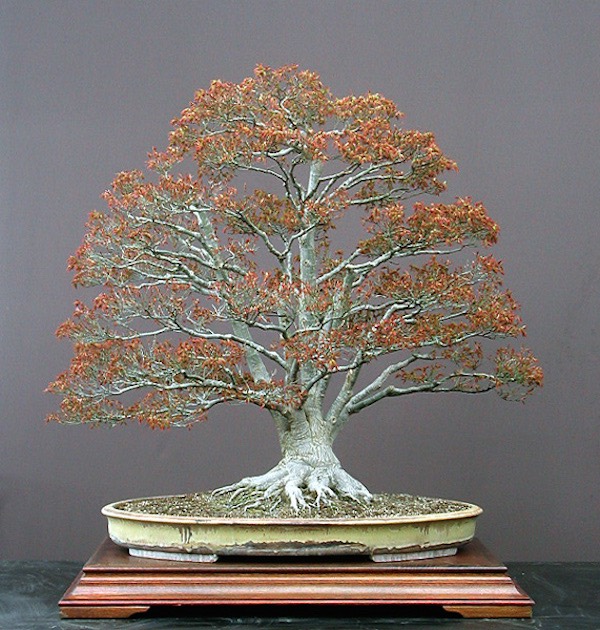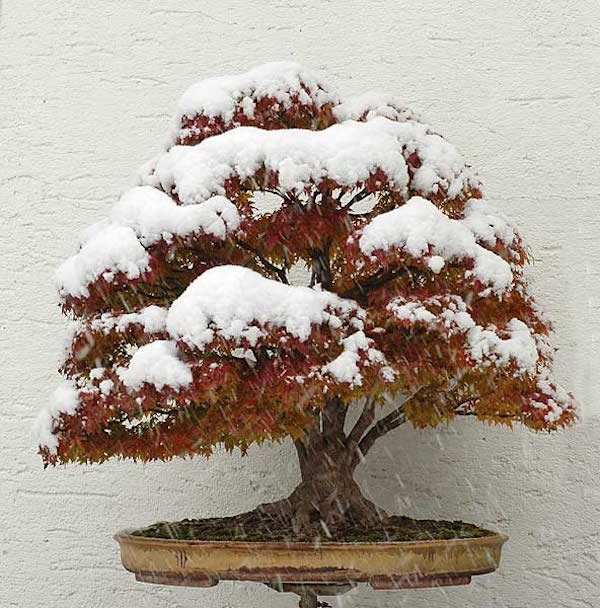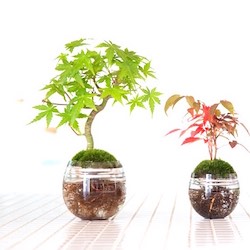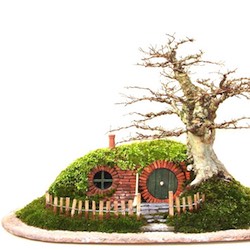In 1993 Walter saw this maple in Switzerland. “It impressed me very much, although it was in a very neglected state”. It was imported from Japan around 1980 from a major Bonsai nursery. It had not been treated very well.
Walter was able to purchase the tree, and since years, this tree is one of the best known trees in Europe. In the article he reviews the progress the tree made, and the qualities and flaws of the tree.
Kiohime Maple, qualities and flaws
Folks did not know that it had the typical problems of the Kiohime variety. The top tends to be weak, branches are extremely brittle and it has to be repotted at least every two years. So the tree, which used to cost a small fortune, went downhill for years.
Finally it was for sale as a sort of left-over, second rate tree. The top was weak and a couple of branches were broken off, especially in the upper part. The pot was way too small. The tree as a whole was totally overgrown. It had not been repotted in many years. It had not been cut back in many years either. The trunks appeared too straight and had almost no taper. The tree had an ugly knob on top of the main trunk.
Anyway, I had the strong feeling that this one I could handle and make my prime Japanese maple. I knew that I had to live with some of the faults and camouflage them. The main trick was to achieve an aura that is so strong that the faults disappear in the viewer's eyes. It is like with a person that has a very strong appearance, an aura, an unforgettable character. The person will be full of faults, but it does not matter, the aura is stronger.
This probably was my best deal in Bonsai. See the progress below in photos. It is not exactly a Kiohime, but close to. As far as I understand there is no name for this variety, it is close to the wild form, only has smaller leaves. And the bad habits of Kiohime.
Walter continues his story below, but first let's see some photos!
The Maple's progress from 1993 to 2015

October, 1993

March 1994, before repotting

March 1994, after repotting

June, 1995

April, 1998

April, 2000

August, 2004

April, 2005

November, 2011

April, 2007

November 2007

April, 2009

March, 2011

July, 2013
Repotting the Japanese Maple Bonsai

Repotting; removing the tree from its pot.

Repotting; putting the tree on a turning table, to be able to remove the soil from the roots.

Repotting; removing the soil.

Repotting; the tree back in its pot, with fresh substrate.
Tree Critique
This maple is a very good example to discuss tree critiques. By and large the general public is quite enthused about this tree. Folks come up to me frequently and tell me how much they love this maple. Folks who see it in person in my garden are often overwhelmed.
Yet there are some who point out that it is just mediocre. Well, it certainly has it's faults. And it certainly is not the best maple around like some dare to suggest.
One thing is for sure: one does not have to understand anything about bonsai to appreciate this tree.
It seems especially attractive to the general public and the photographs of this maple are best-selling. So does this mean that it is kitsch? Well, could be, but also kitsch has it's merits. One can judge a bonsai with the heart, with the soul and come to a conclusion that it touches the soul; it touches it in a tremendous way.




Rules and conventions VS Aesthetics and natural beauty
One can also judge a bonsai with the intellect, with what one KNOWS to be good and KNOWS to be faults. Then this particular tree might be mediocre. The question is which sort of judging is the 'correct' one. And the question is whether the positive features are so strong that they way overshine the faults. And then some 'faults' may be just in the minds of gardeners (and not artists). E.g. the fact that the sub-trunks come out of the main trunk either too high for a multitrunk or too low for a broom form is a major fault for some fundamentalists. Well, go look at real trees and not at bonsai forms and go re-write the bonsai books, taking this maple as an example.
Fact is that this tree was a second or third rate bonsai back in Japan. It most probably was meant to be a multi-trunk and went wrong - the cut was too high. Insiders who know this are often unable to appreciate this maple. They see it as third rate tree still. They don't see or refuse to see that I have changed this into a broom form with a very short trunk, thus having turned a major fault into a major feature. Since this form is not in the bonsai books it must be bad. People who know less have no problem to appreciate what I did.
Anyway, it is kind of amusing to listen to these discussions. And it is kind of pleasing to own this tree and be able to say that I have made it to what it is today. Life has been good to me.
What do YOU think?
What do you think of the tree? Is it simply wrong? Or is it a natural beauty? Join the discussion about the Maple on Facebook, Twitter, Instagram, Pinterest, or Tumblr.




